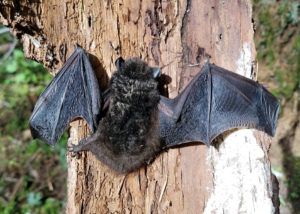You could say we’re a bit batty for bats at Northwest Trek. We appreciate what bats offer our ecosystems — and because of that, we work hard to protect them. Northwest Trek is home to one of the largest wild bat colonies in the South Puget Sound region. The bats roost under the eaves of many of our buildings and around the wildlife park, including in all the bat boxes we’ve put on trees.
Protecting bats is important
Bats keep us all healthy. Pacific Northwest bats are insectivores, consuming their own body weight in bugs every night. If we didn’t have bats, we would get eaten alive by mosquitoes – and farmers would have a much harder time growing our food. Other American bats also pollinate plants as they fly around. If you drink tequila or admire saguaro, you can thank a bat. They are the key pollinators of agave and cactus plants.
Bat Research
Northwest Trek employees and volunteers are helping to protect bats through science and research. In partnership with staff from Washington Department of Fish and Wildlife, we count and study them to look for white-nose syndrome, a deadly disease that is devastating bat colonies around the country.

White-nose syndrome is a fungus that grows on the noses, wings and ears of bats during winter hibernation. Named after its white, fuzzy appearance, it invades deep skin tissues, irritating the bats as they hibernate. Bats with this disease awaken more frequently during hibernation, which leads to them burning through the fat reserv
es they need to survive. In eastern North
America, the disease has killed over six million bats, wiping out some colonies.
White-nose syndrome was first found in King County in 2016. Each year, staff and volunteers at Northwest Trek collect about 25-30 samples from the park’s colony to test for the disease. So far, our bats are healthy – there’s no health risk to humans – and they are helping scientists understand how to protect their species.
“Everyone can help protect bats,” says Rachael Mueller, who leads annual wild bat counts at Northwest Trek. “Improve bat habitat around your home by reducing outside lighting and protecting trees, streams and wetlands. And protect them from disease by staying away from their roosting sites. We need bats, and like all wildlife we can live in harmony with them if we give them space.”
Do Your Part
We can all help prevent white-nose syndrome from spreading around bat colonies.
- If you ever see sick or dead bats, report them to the Washington Department of Fish and Wildlife at 360-902-2515 or wdfw.wa.gov/bats
- Avoid entering areas where bats may be living to limit the potential of transmitting the fungus that causes the disease and disturbing vulnerable bats.
- Do not allow pets to access areas where bats may be roosting or overwintering as they may carry the fungus to new sites.
- Help improve bat habitats by reducing lighting around your home, minimize tree clearing, and protect streams and wetlands.
- Incorporate one or more snags into your landscape, keeping old and damaged trees when possible. Snags provide important habitat for bats and other backyard wildlife.
A reminder to NEVER handle a live bat with your bare hands. White-nose syndrome does not pose a threat to humans, pets or other animals but the bat could be infected with rabies.
To read more about what we’re doing to protect bats and what you can do to help, click here.